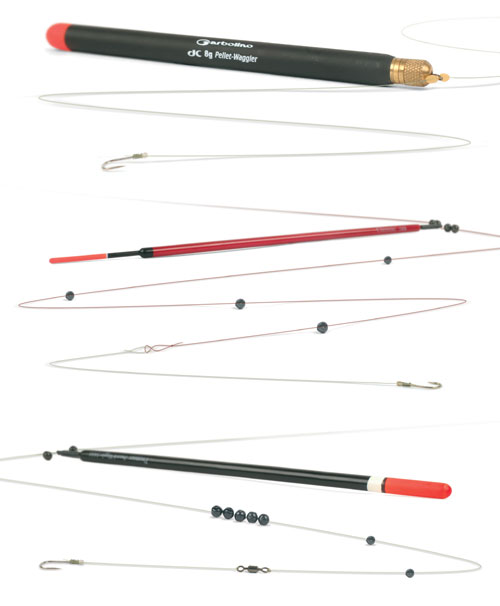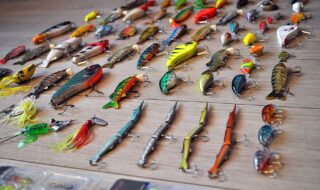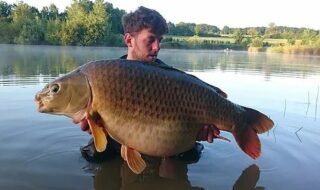What Is A Waggler?
In contrast to a stick float, which is attached at the top and bottom with rubbers, a waggler is attached at the bottom only. The line goes through an eye or swivel at the base, and is usually locked in place by split shot. There are dozens of patterns of waggler to suit all manner of angling situations – we’ve listed the main ones and their uses in this guide.
How Do I Understand Shotting Patterns?
If you’re new to waggler fishing, the best bet is to follow a simple guideline that around 80 per cent of the loading should be placed around the base of the float to lock it in place, with the rest down the line. As the float hits the water, it sits upright and sinks down almost to the base of the brightly coloured tip. Smaller shot are used to create a slow fall of the hook bait through the water to mimic the loose feed. When these small shot are equally spread out from the locking shot to the float it’s called ‘shirt button’ shotting. When the final small shot has settled, only the very tip of the float should show above the surface. For example, with a 4AAA waggler you might lock the float in place with 3xAAA shot plus a BB shot, and then place six No8 shot down the line.
What Is Bulk Shotting?
This is when the smaller dropper shot (the No8s in the example above) are placed together down the line. It is used when you need to get the bait down through the surface layers quickly. This could be when you need to get through small, surface-feeding fish (such as bleak) and is a common shotting pattern on rivers to allow you to get the hook bait down into the catching zone near the bottom as quickly as possible.
What Tackle Do I Need?
Generally speaking, you don’t need robust tackle when waggler fishing. For normal river and stillwater fishing for bags of smallish fish, main lines in the 3lb to 4lb bracket with hooklengths of 2lb to 3lb are about right. You would fish lighter still for silver fish on canals and drains.
For general waggler work a 13ft rod is fine. If you fish rivers a lot, a 14ft model will help you mend the line easier. Almost all the major tackle brands market three-piece waggler or float rods, which tend to have quite fine tip sections. These react to the lunges of big and small fish and allow the use of these light hooklengths. When fishing for bigger fish such as carp and tench, and when using some of the larger wagglers highlighted here, you need to step things up. With splasher, pellet and speci-type wagglers, look to use 6lb main lines straight through with ‘power’ waggler rods. Many rods have their line-rating range printed on them.
Reels-wise, just go for a normal match-style reel, but make sure that the line is loaded to the edge of the spool so that you can cast smoothly.
Plumbing Up
For the uninitiated plumbing up with a waggler is quite difficult. If you leave the float attached bottom end only it’s hard to get a very positive reading of depth, especially on flowing water. The trick is to temporarily convert the waggler into a stick float and attach it top and bottom. To do this, create a half hitch in the line above the float, loop it over the base of the tip and tighten up. You can now flick the rig out underarm and plumb up with the rod tip high. When you have the correct depth, place the hook into the lowest rod ring, tighten up, and make a mental note of which rod ring the locking shot at the base of the float come to. That way, if you need to set up again, or alter the depth, you can quickly go back to the correct depth without having to plumb up again.
Sinking Your Line
When you’re fishing on a stillwater, drain or canal, you need to sink the line between the rod tip and the float to prevent the float being dragged out of position by crosswinds. To do this, simply place the rod tip under the surface of the water and quickly turn the reel handle a couple of times. If you need to sink the line without bringing the float towards you, for example, if you’re fishing tight to a feature such as an island and need to keep your bait there, the same can be achieved by putting the rod tip under the water and flicking it upwards sharply. You may need to do this a couple of times. Most main lines sink quite well, but the process of sinking the line can be greatly helped by treating the spool with a line sinkant, such as a 50/50 mix of washing-up liquid and water.
Fishing On Rivers
River anglers fishing the waggler need a different requirement from their main line. Because the water flows faster through the surface layers than at the bottom, the line just above the float is always going to be pushed in front (downstream) of the float once you start letting it run through the swim. If you allow this to happen, the float (and thus the hook bait) will be dragged through the swim too fast, ruining presentation. So, river float anglers regularly have to ‘mend’ the line, which means lifting the line off the surface with the rod held high, bringing the line back upstream of the float. Hence, river float anglers look to fish a main line that doesn’t sink too deeply, and many apply a line floatant (such as Mucilin, as used by fly anglers) to the six feet or so above the float.
Casting Practice
It’s important that the float doesn’t land in a heap when it hits the water. This would only cause tangles. You need to ensure that the rig straightens out just as it lands, with the float hitting the water nearest you, followed by the dropper shots, with the hook bait furthest away. This is easier to do than it sounds. Casting with the rod directly overhead, punch out the waggler. As it’s about the land, check the line by dabbing your finger against the reel’s spool. Remember to pick a permanent far-bank marker so that you’re always casting to the same spot. On rivers, casting slightly downstream rather than directly in front will help you control the line behind the float better.
Feeding Patterns
If you are fishing in open water, it’s good practice to feed first and then cast the waggler past the feed. As you sink the line, draw the float over where the feed has landed. This will see your hook bait falling through the layers of water with the loose feed. If you need to keep the feed tight, such as when you are close to a feature, don’t try and feed too much. Putting too much feed into the pouch will see you spray bait all over the place. Feed a pinch at a time and you’ll find that it lands tighter to the chosen spot.
Feeding groundbait to a waggler is specialised, but you may need to do it if you fish spasher-style wagglers on commercial fisheries. The trick to consistently achieving the same distance is to feed the same-sized balls and always bottom out the elastic.
What Is A Slider?
Slider fishing is using a waggler to fish in deep water. If the water is deeper than the length of your rod and you need to fish on the bottom, it’s impossible to cast it if you lock the float in place with shot. With a slider, the float sits on a bulk of shot below it, but is free-sliding above it. A sliding stop knot is then tied onto the main line at the correct depth. This knot slides through the rod rings (leaving the tags an inch and a half long helps this), allowing you to fish at any depth you like. The bulk the float sits on is around four feet from the hook, making it easy to cast. When you cast out, this bulk sinks and the line slides through the eye at the bottom of the float until it hits the stop knot, when it ‘cocks’, ready for fishing. Slider fishing is quite specialised and not used in the UK much these days. However, on the Continent, where they have a lot of deep venues and where feeder fishing and legering isn’t allowed in competitions, it’s still very popular.
What are pellet wagglers?
Fishing naturally falling baits up in the water on commercial fisheries beyond pole reach or when it’s windy used to be a nightmare. With normal straight wagglers it was difficult to cast to any distance accurately and get the shotting correct, so that the rig wasn’t too sensitive that it dipped with every line bite.
This is where the new pellet waggler floats have come into their own. These are three times the diameter of a normal waggler, very buoyant and carry an adjustable weight that makes them almost self-cocking.
These floats have been specifically designed to be fished shallow with hair-rigged baits. The extra weight in the float acts to make a fish bolt and hook itself once it feels the resistance.
However, fishing up in the water is not the only tactic for which the float is good. Sometimes when fishing over to island margins using a feeder, you can get pestered by loads of line bites as fish dart in and out over the reel line.
With one of these floats and by using floating line, you can cast to the feeder’s landing spot and with very little line in the water, so there’s less chance of getting a false bite.
The Garbolino pellet wagglers are excellent and Premier Floats are working on something similar which (we hear) will be the business.
What is a bagging waggler?
These are a common sight on those commercial venues that allow their use. The best way to describe them is to envisage a Method feeder with 12 inches of balsa wood, shaped like a fat waggler, attached at one end.
Seen as a summer tactic when carp are patrolling the upper levels for food, the bagging waggler is fished fixed with a long hooklength, sometimes half the depth of the area that’s being worked.
The feeder is then loaded with a fairly fine, dry groundbait mix that is sticky enough to survive casting, but breaks up quickly to create an attractive cloud of feed that draws fish into the area and hopefully onto your hook bait (see last month’s issue).
As the rig is fished with no weight down the line, it falls naturally through the water, and when a fish attacks it feels the weight of the float and hooks itself as it bolts.
If you find you’re getting bites as soon as, or just after, the float lands in the water, then it’s a sure sign that the fish are higher in the water. It will therefore pay to shorten your hook link in increments of 12 inches until you connect.
One other fact about fishing the bagging waggler: you need to reel in and recast every few minutes, so make sure you take plenty of groundbait or you could run out halfway through the session.
Top Tip
When placing the locking shot around the float, line up the splits in the shot and make sure that they are flush to each other. This helps prevent wrap-over tangles.
Advanced Tip
A quite recent development is the splasher-style wagglers for carp fishing on commercial venues. These work on the premise that carp will come to the noise of the big float hitting the water, thinking that it’s food. They work on the self-hooking principal and are self-weighted. Some anglers fish them on a loop and others on a paternoster. You can also lock these floats in place, but using shot is not recommended as these are big floats and too much pressure will be placed on the locking shot. Instead, use one of the fixed style of wire connectors shown in the picture.
Advanced Tip
Back shotting is associated with stick-float and pole fishing, but it can also be useful for the waggler angler when there is a strong downstream wind on rivers or a nasty surface drag on stillwaters. Placing a No4 shot 18 inches above the waggler will sink the line directly behind the float, well beneath the surface, and alleviate both problems.
Shotting Size Guide
1SSG = 2AAA
1AAA = 2BB
1BB = 2No1
1No1 = 2No4
1No4 = 2No6
1No6 = 2No8
Shotting Weight Guide
SSG = 2gr
AAA = 1.2gr
BB = 0.4gr
No1 = 0.3gr
No4 = 0.2gr
No6 = 0.1gr
No8 = 0.06gr
No9 = 0.05gr
No10 = 0.04gr
No12 = 0.02gr
Types Of Waggler

Splasher
Used on commercial fisheries when targeting carp up in the water at distances of up to 50 yards. The large tip is designed to make a splash and a noise to attract fish without having to loose feed.

Insert
Seen primarily as a stillwater venue float, this pattern can be shotted down for very sensitive bite indication from shy fish, and is ideal when looking for lift bites as well as sail-away takes.

Crystal
The clear plastic body of this type of float makes it ideal for fishing on clear-water venues in bright conditions. The lack of shadow that falls on the water is less likely to spook fish.

Straight Peacock
The thicker tip of this pattern makes them ideal for fishing on running water when out of stick float range. The extra buoyancy allows you to trip baits over an uneven bottom without the float being dragged under.

Short Peacock
A short, thick straight waggler that takes a large bulk of weight and is suited to fishing shallow water around island features that are out of reach of the pole or in windier conditions.

Speci
An extra-thick float that carries a lot of bulk to allow the angler to fish at distance on big fast-flowing rivers, like the Severn and the Wye, for species like chub and barbel.

Scud
Carrying a bulk of casting weight in the bottom of its body, this pattern is used when casting large, single baits to fish feeding in the upper levels of deepish water. Internally weighted.

Canal
A small, lightweight, normally plastic, float sometimes used on wider canals when the fish are out of pole reach and feeder is not an option in clear-water conditions. Can also be fished with a whip.

Pellet
Fairly new to the waggler family and used on commercial venues for fishing hair-rigged baits at a shallow depth. The thick body acts like a bolt weight that causes the fish the hook itself as it takes the bait.

Driftbeater
Also called an antenna float and designed for windy days when there is a lot of surface movement; the thin stem avoids the tow while the bulbous tip shows up well in choppy water conditions.

Stillwater Blue
Used for presenting a bait on the drop. The long, thin antenna is very sensitive and shows a positive bite as the spread shot settle. An ideal float for fishing hemp and tares.

Polaris
Used for float-legering on deep stillwaters, it locks onto the reel line by an innovative mechanism that uses friction when the reel line is tightened against a bomb or feeder.
Slider
You can use any float as a slider but the best have a long antenna that sinks gradually as the bulk and shot settle with a very visible tip and a decent body. At tcf we prefer sliders that are partly loaded in the base as this helps keep the base of the float on the bulk of shot diring flight, thus cutting down on tangles.
Puddle Chucker
A dumpy, clear-plastic float that is used primarily on commercial waters by anglers fishing for small species like roach on the drop in clear-water conditions. A popular choice in the winter.
Self-Cocking
Any pattern of float with enough weight in the base that requires little or no shot on the line for it to sit correctly in the water.






